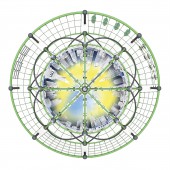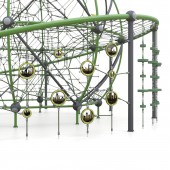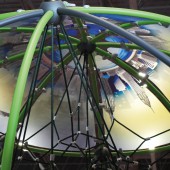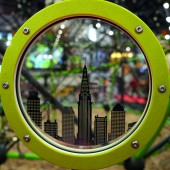
| THE AWARD |
| CATEGORIES |
| REGISTRATION |
| SUBMIT YOUR WORK |
| ENTRY INSTRUCTIONS |
| TERMS & CONDITIONS |
| PUBLICATIONS |
| DATES & FEES |
| METHODOLOGY |
| CONTACT |
| WINNERS |
| PRESS ROOM |
| GET INVOLVED |
| DESIGN PRIZE |
| DESIGN STORE |
| THE AWARD | JURY | CATEGORIES | REGISTRATION | PRESS | WINNERS | PUBLICATIONS | ENTRY INSTRUCTIONS |
New York Play Unit by Cemer Playground Equipments |
Home > Winners > Design #158853 >Interview |
 |
|
FS: What is the main principle, idea and inspiration behind your design?
CE: The main principle behind our design, "New York," is to provide children with a playful and engaging environment inspired by the iconic imagery of New York City. The idea stemmed from creating a structure that not only offers physical challenges through climbing elements but also stimulates imaginative play with its thematic design.
FS: What has been your main focus in designing this work? Especially what did you want to achieve?
CE: Our main focus in designing this work was to blend the unique shape and colors of an apple, symbolizing New York City, with functional play elements that enhance children's physical and cognitive development. We aimed to achieve a design that encourages active play, improves motor skills, and fosters creativity through role-playing opportunities.
FS: What are your future plans for this award winning design?
CE: Our future plans for this award-winning design include exploring opportunities to partner with playground equipment distributors worldwide to bring the "New York Play Unit" to more parks, schools, and public spaces. We aim to expand its availability and impact by catering to diverse global markets.
FS: How long did it take you to design this particular concept?
CE: The design process for this concept spanned approximately 12 months, from initial ideation and concept development to prototype testing and final adjustments based on user feedback and safety assessments.
FS: Why did you design this particular concept? Was this design commissioned or did you decide to pursuit an inspiration?
CE: We designed this concept based on our own inspiration to create a thematic play structure that pays homage to New York City's cultural significance, particularly its association with the Big Apple symbolism. This design was internally driven rather than commissioned, aiming to innovate within the playground equipment sector.
FS: Is your design being produced or used by another company, or do you plan to sell or lease the production rights or do you intent to produce your work yourself?
CE: As Cemer Playground Equipments, we are manufacturing the design ourselves.
FS: What made you design this particular type of work?
CE: We chose to design this particular type of play unit to offer children a distinctive and memorable play experience inspired by one of the world's most recognizable cities. The apple shape, synonymous with New York, serves as a creative focal point that merges thematic design with functional play elements.
FS: Where there any other designs and/or designers that helped the influence the design of your work?
CE: While the initial concept was developed internally, we consulted with structural engineers, material specialists, and playground safety experts to ensure the design's feasibility, safety compliance, and durability. Their input was invaluable in refining the technical aspects of the "New York Play Unit."
FS: Who is the target customer for his design?
CE: The target customers for this design include municipalities, schools, parks, and developers seeking to enhance their recreational offerings with a visually striking and engaging play structure. It caters primarily to children aged 5 and above, promoting active play and imaginative exploration.
FS: What sets this design apart from other similar or resembling concepts?
CE: What sets the "New York Play Unit" apart is its thematic integration of the Big Apple motif, combined with robust climbing and interactive play features. The use of polycarbonate panels with a New York silhouette adds a unique visual element while allowing natural light to filter through, enhancing the play experience.
FS: How did you come up with the name for this design? What does it mean?
CE: The name "New York" was chosen to evoke the iconic imagery and symbolism associated with the city, particularly the concept of the Big Apple. It aims to resonate with both children and adults familiar with New York City's cultural identity.
FS: Which design tools did you use when you were working on this project?
CE: We utilized a variety of design tools including CAD software for 3D modeling, structural analysis tools for safety assessments, and simulation software to test the structural integrity and durability of the materials used.
FS: What is the most unique aspect of your design?
CE: The most unique aspect of our design is the incorporation of a three-dimensional climbing net inside a spherical structure, mimicking the shape of an apple. This design feature not only challenges children physically but also encourages imaginative play within a thematic urban environment.
FS: Who did you collaborate with for this design? Did you work with people with technical / specialized skills?
CE: We collaborated extensively with our in-house design team, which includes engineers specializing in structural design, materials science experts, and playground safety consultants. Their technical expertise ensured that the "New York Play Unit" met stringent safety standards and design specifications.
FS: What is the role of technology in this particular design?
CE: Technology plays a critical role in enhancing the durability and safety of the "New York Play Unit." Advanced materials such as galvanized wires with patented tensioning systems, polycarbonate panels for transparency and impact resistance, and stainless steel components for structural support were integral to its construction.
FS: Is your design influenced by data or analytical research in any way? What kind of research did you conduct for making this design?
CE: Our design was influenced by extensive research into playground safety standards, child development principles, and urban design aesthetics. We conducted data-driven research to optimize the play experience, ensuring that each element promotes physical activity and cognitive development in children.
FS: What are some of the challenges you faced during the design/realization of your concept?
CE: Some challenges we faced during the design and realization of our concept included integrating the complex three-dimensional climbing net within the spherical structure while maintaining safety and aesthetic integrity. Additionally, ensuring the apple-shaped cover was interchangeable and durable posed manufacturing challenges.
FS: How did you decide to submit your design to an international design competition?
CE: We decided to submit our design to international design competitions like the A' Design Awards to gain global recognition, showcase our innovative approach to playground design, and benchmark ourselves against industry peers on an international stage.
FS: What did you learn or how did you improve yourself during the designing of this work?
CE: Through the process of designing the "New York Play Unit," we learned valuable lessons in material science, structural engineering, and user-centered design. We improved our capabilities in integrating thematic elements with functional play features, enhancing both aesthetic appeal and play value.
FS: Any other things you would like to cover that have not been covered in these questions?
CE: One additional point worth mentioning is our commitment to sustainability. We aim to explore eco-friendly materials and production processes in future iterations of this design, aligning with global trends towards environmental responsibility in manufacturing.
FS: Thank you for providing us with this opportunity to interview you.
A' Design Award and Competitions grants rights to press members and bloggers to use parts of this interview. This interview is provided as it is; DesignPRWire and A' Design Award and Competitions cannot be held responsible for the answers given by participating designers.
| SOCIAL |
| + Add to Likes / Favorites | Send to My Email | Comment | View Press-Release |





